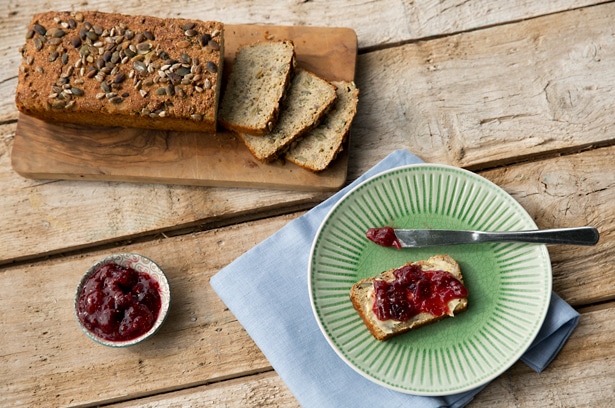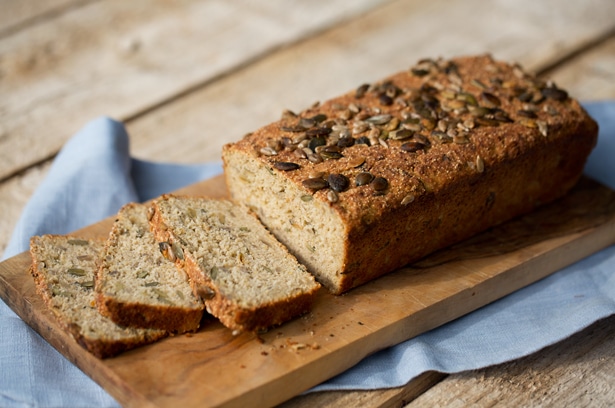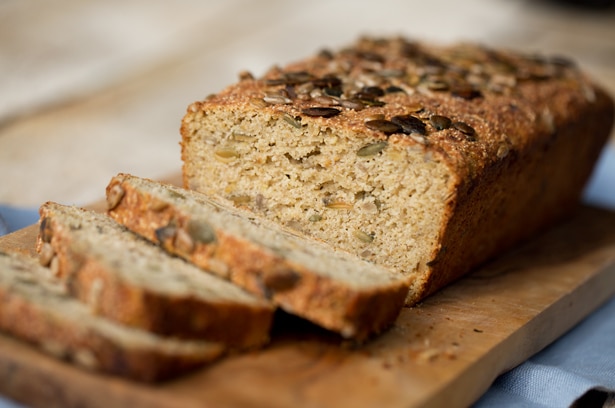Gluten-free Wholemeal Bread
What you should know about gluten intolerance

In the last few months it has become increasingly clear that my husband Thomas does not tolerate gluten. During our vacation in Alaska and Canada, his complaints got so bad that he radically cut gluten from his menu –and he got a lot better very quickly. He has not yet taken a test, but his condition alone speaks volumes. In general, gluten tests are not as accurate as you might think. To do this, you first have to understand what gluten actually is.
What is gluten
Gluten is a mixture of different proteins that are found in wheat as well as in other types of grain such as spelt, rye, oats (very small amounts), kamut, emmer, einkorn and barley. In the grain growth process, gluten fulfills the function of providing the seedling with stored nutrients. When baking, the gluten works like a glue that holds the pastries together well. There are two different groups of proteins in gluten: the prolamins and the glutelines. Depending on the type of grain, they differ somewhat in their structure. That is why the prolamins in wheat are called gliadins, for example, but in oats, for example, avenins. Of these sub-categories there are further sub-categories such as alpha, beta, gamma and omega-gliadin. So far, so complicated.
A test for gluten intolerance usually only looks for antibodies against gliadin, which is typical of wheat, in the alpha and beta version. Since an intolerance can also be triggered by one of the other substances in gluten, it is possible that one of the intolerance tests turns out negative, but gluten is still not tolerated.
The good news is that people with celiac disease can be safely diagnosed from a biopsy and certain blood markers. Anyone else who has a potential intolerance can easily find out whether their symptoms are gluten-related or not: they simply leave the gluten out completely for 60 days and then assess whether they feel better or not.
What are the typical symptoms of gluten intolerance?
While the severe form of gluten intolerance, celiac disease, shows clear symptoms (diarrhea, abdominal pain, weight loss, nutritional deficiency), gluten intolerance is not always that easy to recognize. For many people, the symptoms do not start immediately after consuming a gluten-containing dish, but often up to 72 hours later. And the complaints themselves are also not very easy to identify.
These are the most common signs of gluten intolerance:
- Digestive discomfort with diarrhea, constipation, or both alternately. Often treated by doctors as irritable bowel syndrome.
- Irritability and/or depression.
- Migraine. Studies show that gluten intolerance can lead to neurological disorders including frequent headaches and migraines.
- Tingling and numbness in the arms and legs and dizziness can indicate an intolerance.
- Autoimmune diseases such as Hashimoto’s chronic thyroiditis are negatively affected by gluten intolerance.
- Fibromyalgia, which means muscle and connective tissue pain, can be a result of gluten sensitivity.
- Persistent fatigue such as chronic fatigue syndrome is a common symptom of intolerance that should improve the fastest after a change in diet, according to studies.
The greatest fear when a gluten intolerance is suspected: “Then I can’t eat any more bread!”
I believe that there are many people who are more willing to take on health problems than to change their eating habits. And when it comes to the beloved bread, the change is particularly bad. Of course you can buy gluten-free bread in the store, but it usually doesn’t taste particularly good and often has a crumbly and dry consistency.
Since I love culinary challenges and had already dealt with gluten-free baking while working on my book “Suess&Gesund”, I got down to work straight away. And it didn’t take long before I pulled a good gluten-free bread out of the oven. Before that, I had my own doubts (which I had kept a secret from Thomas) whether it was even possible to bake a really delicious gluten-free bread – but it works! And it’s very easy.
And now my question for you: did you ever experience any food intolerances or have someone close in the family who has? How did you manage the transition? Please let me know in the comments below!

GLUTEN-FREE WHOLEMEAL BREAD
Ingredients
- 1/2 cube of fresh yeast
- 350 ml lukewarm water
- 1 tbsp maple syrup
- 200 g whole grain rice flour
- 100 g buckwheat flour
- 100 g millet flour
- 50 g pumpkin seeds plus 1 tbsp to sprinkle the bread
- 50 g sunflower seeds plus 1 tbsp to sprinkle the bread
- 2 tbsp ground flaxseed
- 3/4 tsp cumin seeds optional
- 1.5 tsp salt
- some freshly ground black pepper
Equipment
- 25 cm long loaf pan
Instructions
- Mix the yeast with lukewarm water and maple syrup in a bowl. Let stand for 5 minutes.
- In a large bowl, mix all types of flour with kernels, ground flax seeds, cumin seeds, salt and pepper. Mix in the yeast mixture with a wooden spoon until a sticky, viscous dough is formed. Cover the bowl with a clean tea towel and let the dough rise for 1 hour in a warm place (for example in the oven that was switched on and off briefly beforehand).
- Grease an approx. 25 cm long loaf pan and fill it with the dough. Cover with the tea towel and let rise for another 20 minutes.
- Position a baking sheet with a rim on the bottom rail of the oven and a baking rack in the middle. Preheat the oven to 240°C.
- Spread the tablespoon each of pumpkin and sunflower seeds on the surface of the bread and press lightly with your hands.
- Place the loaf tin with the bread dough on the middle rack. Pour a cup of water on the lower baking sheet (be careful, the water evaporates very quickly, so do not hold your face too close to the opening, otherwise you will get the hot water vapor!).
- Reduce the oven temperature to 220°C and bake the bread for 30 minutes.
- Let cool in the loaf pan for 5 minutes, then use a blunt knife to separate the dough from the sides of the loaf pan and remove it from it. Let cool down completely.
- Store wrapped in a clean tea towel and consume within three days.


